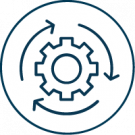Background
Thanks to a sharp decline over the last decade, the cost of offshore wind-generated electricity has reached grid parity in favorable cases. Nevertheless, in view of the massive use of electricity generation for the energy transition, it is vital to continue lowering production costs.
The CELT4Wind project winner of the WEAMEC Research call 2020 targets the the Cable Electrothermal Management for Offshore Wind Farms.
CELT4Wind is coupled with the OWARD project winner in 2016 and the ORIGAMI project winner in 2019.
Scientific advances and innovation
CELT4Wind: Cable Electrothermal Management for Offshore Wind Farms
The CELT4Wind project aims to contribute to the necessary cost reduction by targeting significant investment savings, focusing in particular on savings on the wind farm export cable. This cable benefits indeed from a very high thermal inertia, i.e. it may take several days or even months of operation at full power before it reaches its maximum allowed temperature, which is the limiting factor for energy transmission.
Some Transmission System Operators (TSOs), who are now responsible for the electrothermal management of this cable in more and more countries, have begun to take into account the possible exploitation of this phenomenon, thus maximizing electricity production with a constant electrical infrastructure. For a number of years now, some of these grid operators have been authorizing offshore wind farm operators to size their wind farms to a higher power than can be transited by their export cable under steady-state conditions. These farms only produce at full power for a fraction of the time, so the temperature of the cable slowly rises, due to the phenomenon of thermal inertia, during the period of full-load production, while remaining below its maximum permissible temperature, since full load is only maintained temporarily. This “undersizing” of the cable can therefore result in considerable investment savings. However, exploiting the thermal inertia of export cables poses a number of scientific and technical challenges.
Optimized, real-time electrothermal management by a TSO of a cable connected to a wind farm, whose production is controlled by a farm manager, requires a dialogue between these two players, the basis of which has yet to be defined in terms of the type and temporal precision of the information exchanged. In fact, the TSO needs to specify relevant operating conditions that can be met by offshore wind farm managers, as part of the bidding process for offshore wind farms. This is the challenge that the CELT4Wind project sets out to meet. It aims to address this issue from a necessarily multi-player perspective, involving a TSO (RTE), an offshore wind farm developer/manager (WPD) and an offshore test site manager (SEMREV). The project also needs to be multi-disciplinary, and therefore brings together researchers from electrical and thermal engineering (SATIE and IREENA).
It is based on four pillars:
- the generation of offshore wind power generation datasets (supplied by RTE) based on historical wind meteorological data representative of conditions on the French Channel/Atlantic coast, which can be cross-checked with actual measured data (supplied by WPD);
- the development of electrothermal models of the offshore cable, combining accuracy and computing time compatible with real-time constraints;
- the development of an electrothermal management module that takes account of uncertainties, particularly those linked to electricity production forecasts;
- the drafting of recommendations for technical specifications to be included in future tenders for offshore wind farms.
Expected technical and economic impact
The expected impacts of the CELT4Wind project are to obtain:
- a real-time model of optimal electrothermal management of the export cable that can be reused for future projects;
- a realistic dialogue protocol for electrothermal management of the export cable between the transmission system operator and the offshore wind farm operator, respecting the requirements and technical constraints of the parties involved.
Key project milestones
- September 2020 - Kick-Off of the project
- September 2022 - End of the project
Results
The MATLAB code and data from this project are openly available on Github, in accordance with the principles of open science.
Publications and papers published
Publications
-
- 2021-BLAVETTE A.-Upgrading wave energy test sites by including overplanting: a techno-economic analysis-Projet WEAMEC “CELT4Wind”
- 2022 – I. Daminov, S. Bourguet, A. Blavette, T. Soulard, D. Trichet, G. Wasselynck, H. Ben Ahmed, L. Dupont, A. Godard, P. Warlop, Optimal energy management of offshore wind farms considering the combination of overplanting and dynamic rating – Results of the CELT4Wind project – CIGRE accepté à paraître et à présenter en 2022
- 2023 – I. Daminov, A. Blavette, S. Bourguet, H. Ben Ahmed, T. Soulard & P. Warlop, Economic performance of an overplanted offshre wind farm under several commitment strategies and dynamic thermal ratings of submarine export cable, Applied Energy, Volume 346, 121326
Oral presentations with avec publication
Oral presentations
2021 – Ildar Daminov, Anne Blavette, Salvy Bourguet, Projet WEAMEC CELT4Wind, Cable Electro-Thermal Management for Offshore Wind Farms, GDR EOL-EMR, Paris, 27/11/2021
WEBINAIRE – REPLAY








